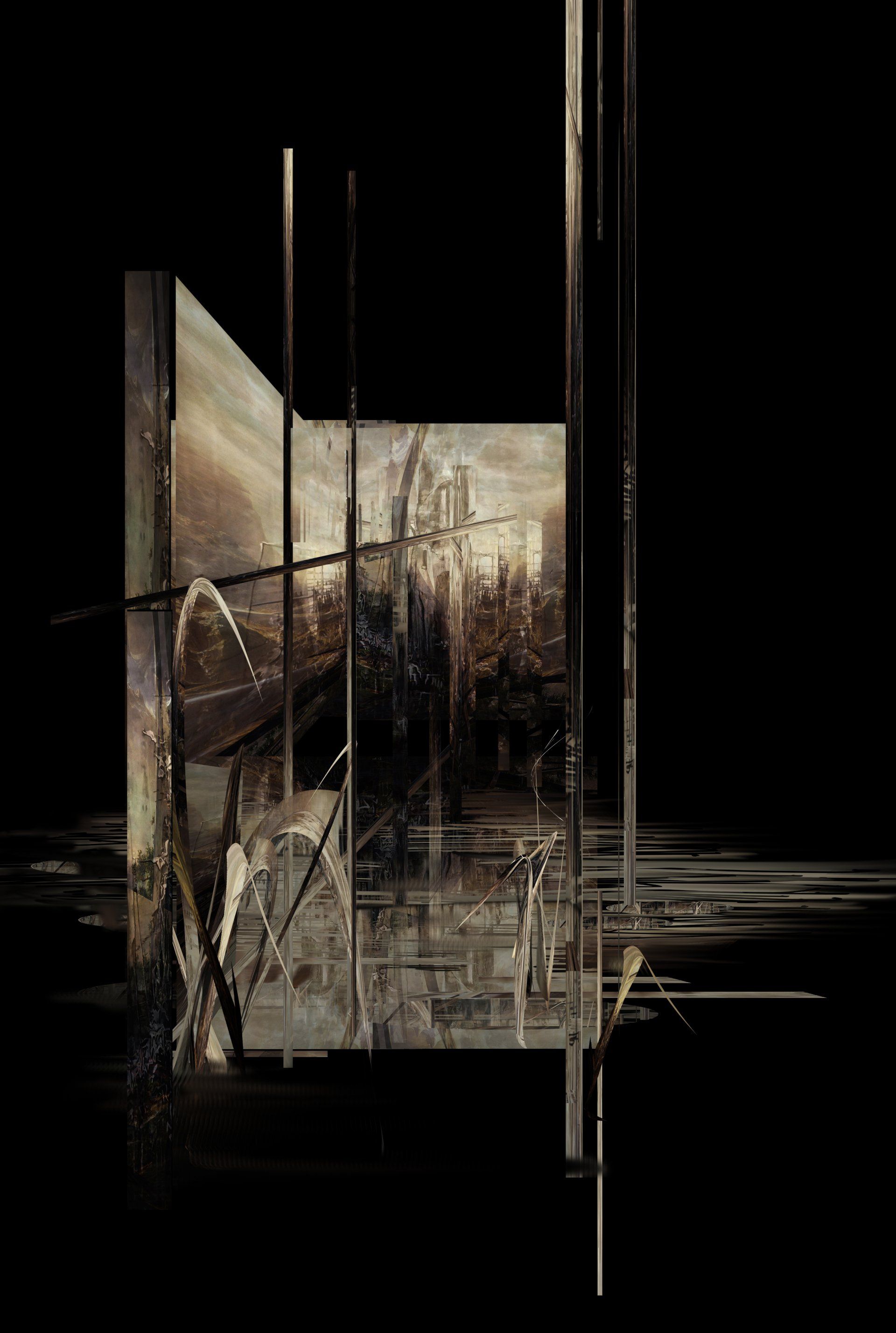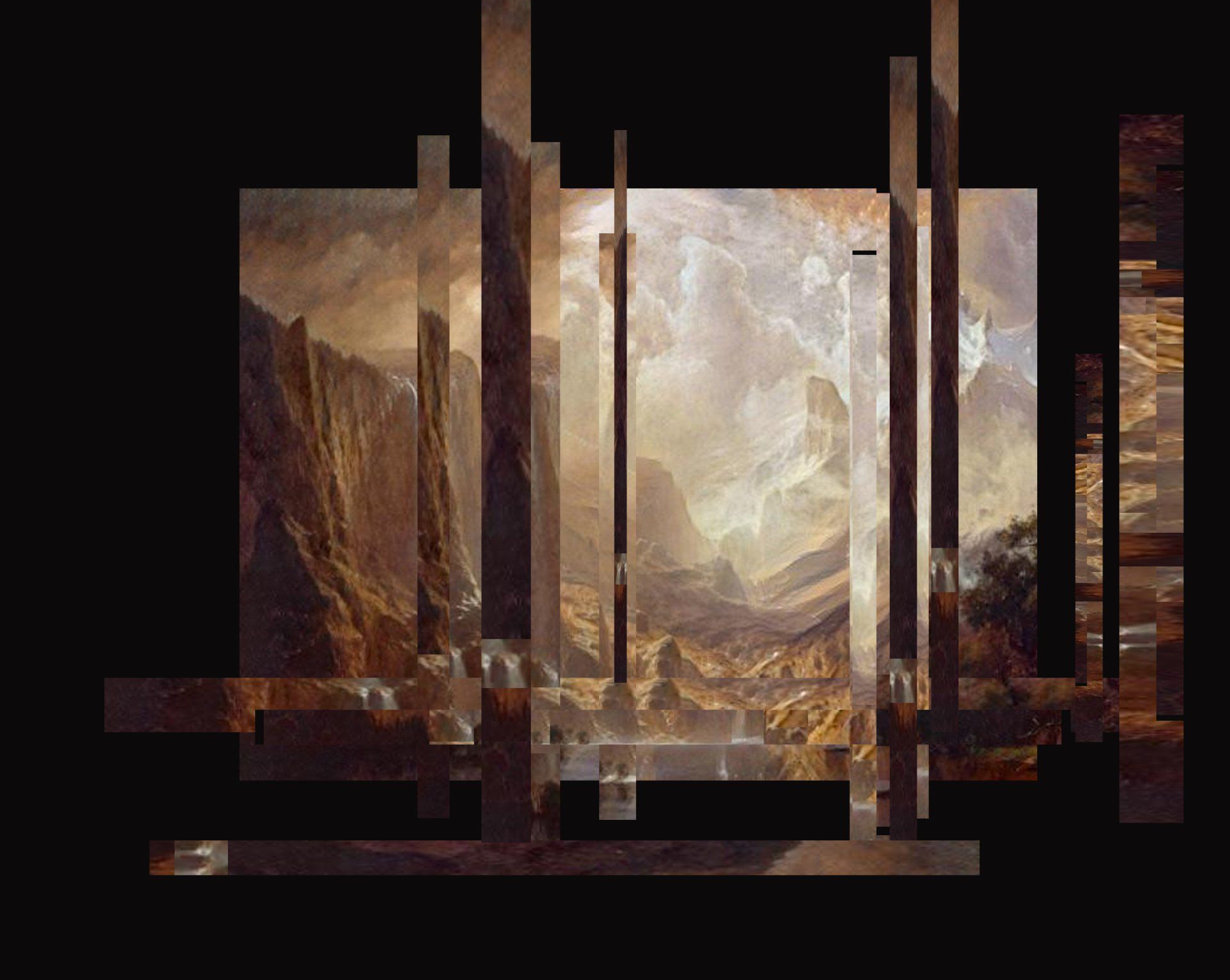Evalutation of my Exhbition at the Doctorate Showcase 2025
1100 words - Estimated reading time: 6 minutes

UEL DOCTORATE SHOWCASE 2025
My inquiry investigates how art, grounded in Jungian and psychoanalytic theories, facilitates the processing of trauma. This work shaped my doctoral showcase, which explored transformation and the Jungian concept of individuation.(1)
I draw inspiration from symbolic imagery that emerges spontaneously during the creative process. For example, symbols such as the labyrinth (The Mirror Labyrinth, 2024), the vortex and mandala (As Above, So Below, 2024), and fragmentation (Lines of Flight, 2024) represent themes of introspection, transformation, and individuation that have guided the direction of my creative practice and research. These symbols reflect the structure of the archetypal apocalypse (2), which, in Jungian terms, symbolises the necessary dissolution and renewal required for psychological integration. (Edinger and Elder, 2002) This pattern can also be seen in my earlier works, such as Babylonian Towers (2022) and Edge of Death (2023), which led to a broader exploration of the metacrisis. (3)
Over the past year, an alchemical framework evolved that focused my practice on an intuitive, material-led process that integrates theory and lived experience. Symbolic forms continue to guide the aesthetic and conceptual direction of the work; the showcase aimed to communicate this affective reality. Following the recent loss of my sister and brother-in-law, the work also became a vessel for personal grief layered upon long-term trauma and complex PTSD. (4) (Moskowitz, 2007)
The curation aimed to inspire symbolic connections rather than create a linear narrative. I wanted to engage with feelings of anxiety and trauma, reflecting a state of psychological change and aligning the space with our shared experience of the metacrisis.
My intention was to create an uncanny and unsettling experience that would enable the audience to engage with trauma and confront the archetypal shadow (5) within a safe and reflective space, echoing the traditional concept of the sublime (Burke and Guyer, 2015). The tension inherent in the sublime between terror and awe, collapse and expansion, reflects the dynamic of duality central to both individuation and alchemy, expressed in the alchemical
coniunctio oppositorum
(6) (conjunction of opposites). The reconciliation of opposites fosters psychic transformation, insight, and integration. a process echoed in contemporary neuroscience, which links the experience of awe, particularly through the arts, to cognitive and psychological change. (Magsamen and Ross, 2023)

Positioned just outside the entrance to the space, The Blackening and Beyond the Blackening introduced the central theme of nigredo, (7) the first alchemical stage of transformation—a symbolic journey through dissolution and symbolic death in preparation for renewal. Both works were composed of small paintings extended by black batons, with Beyond the Blackening referencing and reinterpreting the earlier piece, which explored and questioned perception and illusion.
These works functioned as metaphors for disintegration, aligning with
nigredo
and the archetypal apocalypse, and introduced the theme of fragmentation. Psychic fragmentation disrupts perception through dissociation—an experience I sought to evoke and explore in these pieces. The works challenged the boundaries between perception and reality by disrupting and confusing visual cues with three-dimensional elements that fragmented the picture plane. Positioned before the entrance, they serve as an invitation and a warning, acting as symbols at the threshold of the unconscious and echoing the motif of the limen. (8)
At the centre of the space, The Cot: Prima Materia (9) functioned as a symbolic and perceptual anchor, establishing a spatial hierarchy. This central placement emphasised its role as a psychic axis within the space. It evoked the archetypal forms of the vortex and mandala, from which the surrounding works appeared to emanate. Visually and conceptually, it extended the symbolic architecture developed in The Blackening and Beyond the Blackening, incorporating similar materials and techniques such as fragmentation, extension of the picture plane, and blackening. The act of charring the assemblage with a blowtorch extended its alchemical association with nigredo, suggesting destruction, transformation, and a confrontation with unconscious material.


Upon entering the space, the first painting on the right was Nigredo, with The Fall positioned directly opposite. Continuing clockwise, the next wall displayed The Haunted Self and The Fragmented Self, while opposite these hung The Black Sun. Created with the same intuitive process as Nigredo and The Fall, The Black Sun (Sol Niger) (10) symbolises the alchemical stage of nigredo, exploring psychic transformation through dissolution and integration. Adjacent to this was a monitor displaying the short film The Black Sun: Mise en Abyme, which incorporated the development of the painting The Black Sun.
In my short film, The Black Sun: Mise en Abyme, (11) I aimed to evoke the experience of dissociation as an altered state of consciousness and the fractured inner experience of trauma. My research into dissociation and altered states of consciousness broadened my exploration of perception and the nature of reality, visually examined in the works The Blackening and Beyond Blackening.
My exploration of perception and reality intersected with Baudrillard’s concepts of simulacra, simulation, and hyperreality (11) (Baudrillard, 2019), expanding my earlier studies of the digital sublime (12) and the impact of the exponential development of technology on how we think (Carr, 2020) and relate (Turkle, 2017). These ideas were expressed through recursive and self-reflective imagery in the film and further developed in the paintings The Haunted Self and The Fragmented Self, which extended the mise en abyme technique, and aligned with Freud’s return of the repressed and the uncanny (Sigmund Freud, 1919).
The film-still paintings (The Haunted Self and The Fragmented Self) preceded the film, evoking a sense of uncanny familiarity when observing the moving image. The paintings function as visual echoes when reversing the sequence and viewing the film first. In either direction, these works engaged with the concept of the uncanny, where recognition and estrangement coexist (Sigmund Freud, 1919). The paintings also extended the theme of mise en abyme, creating a layered interplay between repetition, reflection, and fragmented perception. Together, these elements reinforced the exhibition’s central concerns with memory, trauma, and dissociation.


I created the paintings Nigredo, The Fall, and The Black Sun using freeform, intuitive techniques that reflect the Dionysian aspect of my practice, embodying chaos, instinct, and dissolution. In contrast to more structured or representational works, these paintings allowed the unconscious to surface through gesture, materiality, and abstraction. Drawing on Nietzsche’s formulation of the Apollonian and Dionysian (Nietzsche and Tanner, 1993). These opposing forces mirror the movement between order and chaos and the coniunctio oppositorum, where transformation emerges through the reconciliation of opposites.
Carl Jung’s interpretation of alchemical symbolism as a metaphor for individuation, along with the emergence of spontaneous symbols and processes, was evident in the works exhibited at the showcase. The initial alchemical stage of nigredo emerged as the central theme. Material processes such as charring, fragmentation, and blackening evolved in practice as embodied methods for expressing psychic descent. Navigating the space between symbolic death and rebirth encouraged reflection and engagement with trauma and transformation. This integration of Jungian theory, alchemical process, and personal narrative continues to guide my inquiry into how creative practice and aesthetic engagement can serve as catalysts for transformation.
Notes:
(1) Individuation is a central concept in Jungian psychology that integrates conscious and unconscious aspects of the psyche to achieve an authentic sense of Self.
[2] Archetype of the Apocalypse symbolises destruction and renewal. It represents psychological transformation in the cyclical process of death and rebirth as a collective and individual phenomenon.
(3) The metacrisis refers to interconnected global crises such as climate change, economic instability, exponential technological development, and social breakdown that are systemic and overwhelm traditional problem-solving strategies.
(4) Complex PTSD arises from prolonged or repeated trauma, often occurring in early life, such as chronic childhood abuse, neglect, or exposure to unstable caregiving, characterised by symptoms such as emotional dysregulation, intrusive memories, and dissociation.
(5) The Shadow Archetype represents repressed aspects of the self traits that are denied or hidden from conscious awareness that manifest in dreams and projections.
(6) Coniunctionis Oppositorum is an alchemical term popularised by the 15th-century mystic Nicholas of Cusa. It refers to the reconciliation or unity of opposites that express true wholeness by holding opposing forces together in tension until a new synthesis emerges.
(7) Nigredo refers to the initial transformative alchemical stage that represents decomposition and breakdown. In Jungian psychology, nigredo symbolises the destruction of the previous identity as preparation for transformation and renewal.
(8) Limen originates from Latin, meaning threshold and is often used in psychology, anthropology, and art theory to describe moments or locations of transformation, ambiguity, and potential.
(9) Prima Materia is a term from alchemical philosophy referring to the original, undifferentiated substance from which all matter—and spiritual transformation—emerges. In Jungian psychology, it symbolises the raw psychic material at the beginning of the individuation process, often associated with unconscious content awaiting integration.
(10) The Black Sun (Sol Niger) is an alchemical and psychological symbol representing the stage of nigredo, a period of darkness, dissolution, or despair that precedes transformation. In Jungian terms, it symbolises the confrontation with unconscious material that is a necessary descent that may lead to renewal and psychic integration.
(11) Mise en Abyme refers to the self-referential technique where an image, story, or concept is placed within itself to create a recursive loop.
(12) Hyperreality is a concept developed by Jean Baudrillard which refers to the dissolution of the distinction between reality and simulation. Signs and images no longer refer to objective reality but are operated through a self-referential system.
(13) The digital sublime refers to the overwhelming sense of awe, transcendence, or terror evoked by digital technologies, particularly when they exceed human comprehension or control. A term coined by Vincent Mosco.
References
Baudrillard, J. (2019) Simulacra and simulation. Translated by S.F. Glaser. Ann Arbor, Mich: Univ. of Michigan Press (The body, in theory - histories of cultural materialism).
Burke, E. and Guyer, P. (2015) A philosophical enquiry into the origin of our ideas of the sublime and beautiful. Second edition. Oxford, United Kingdom: Oxford University Press (Oxford world’s classics).
Carr, N.G. (2020) The shallows: what the internet is doing to our brains. Updated paperback edition. London: Atlantic Books.
Edinger, E.F. and Elder, G.R. (2002) Archetype of the Apocalypse: divine vengeance, terrorism and the end of the world. 1. paperback print. Chicago, Ill.: Open Court.
Magsamen, S. and Ross, I. (2023) Your brain on art: how the arts transform us. Edinburgh: Canongate.
Moskowitz, A. (2007) ‘The Haunted Self: Structural Dissociation and the Treatment of Chronic Traumatization. By Onnovan der Hart, Ellert R. S. Nijenhuis & Kathy Steele. W.W. Norton. 2006.
Nietzsche, F. (2012) The Birth of Tragedy. Newburyport: Dover Publications (Dover Thrift Editions).
Sigmund Freud (1919) ‘Freud the uncanny.pdf’.
Van der Kolk, B.A. (2015) The body keeps the score: mind, brain and body in the transformation of trauma. London: Penguin Books.












